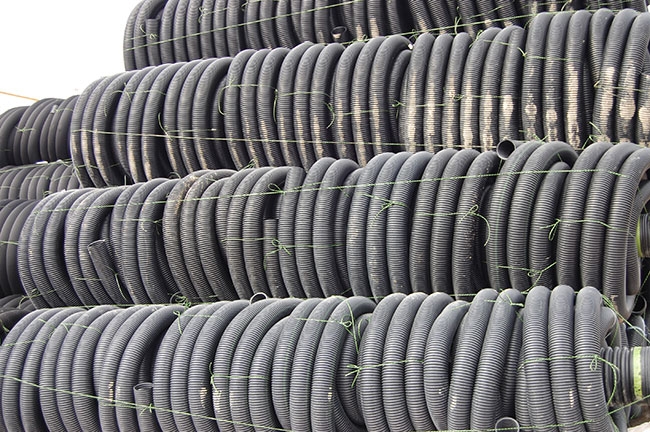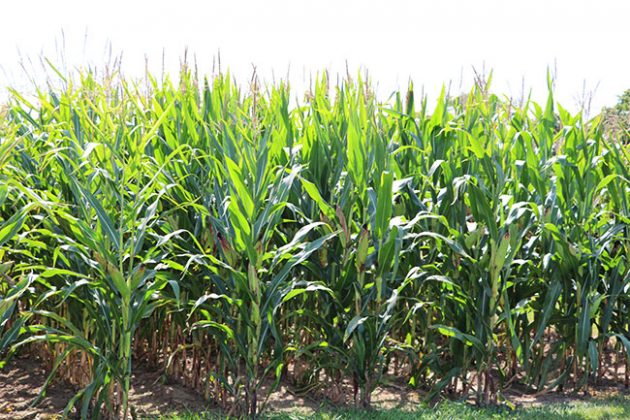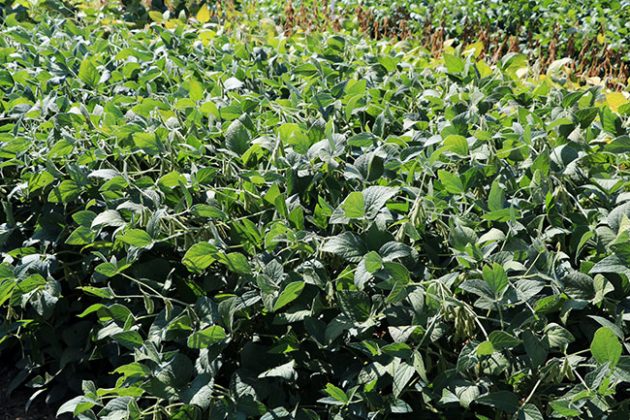
Features
Drainage Management Systems
The right methods for tile drain depth and spacing to reduce nutrient loss
Improving crop profits with tile depth and spacing.
June 7, 2017 By Trudy Kelly Forsythe
 Tile drainage generally enhances crop yields on poorly drained land and helps reduce year-to-year variability in yields.
Tile drainage generally enhances crop yields on poorly drained land and helps reduce year-to-year variability in yields. At last fall’s International Drainage Symposium in Minneapolis, scientists with Agriculture and Agri-Food Canada (AAFC) presented a study on soil fertility, water quality and its relationship with tile depth and spacing.
The project offers significant optimism about the ability to minimize nitrate and phosphorus losses while managing water in intensive agricultural operations.
Chin Tan, a water management research scientist with AAFC, and Tiequan Zhang, a soil fertility and water quality research scientist also with AAFC, designed and authored the study.
Comparing tile depths and spacings
In general, soil drainage enhances crop yields on poorly drained land and helps reduce year-to-year variability in crop yields.
“The design of the tile drainage is to remove excess surface water as quickly as possible when there is excess rainfall over and above the storage capacity of soils during early spring, late autumn and winter,” Tan says. “Good soil drainage is essential to the proper management of wet, fertile soil to be used for agricultural production. Proper management of drainage also plays a major role in improving the water quality from agricultural land.”
The study took place over a four-year period and compared two different tile drain depths and spacings for regular free drainage (RFD) and controlled drainage/sub-irrigation (CDS) systems in a corn and soybean rotation. The theory, based on previous reports that reduced tile spacing led to an increase in tile drainage volume, was that subsurface tile spacing and depth affected the efficacy of tile drainage practices.
The study took place over a four-year period and compared two different tile drain depths and spacings for regular free drainage (RFD) and controlled drainage/sub-irrigation (CDS) systems in a corn and soybean rotation.
According to Zhang, a direct correlation between decreased tile drainage volume and decreased tile depth was also observed in eastern Illinois fields under corn and soybean rotation. This was supported by field studies in both central Ohio and Nova Scotia, which indicated annual nitrate losses for shallow drain depth were reduced by 38 to 40 percent compared to losses for the deeper drain depth.
Evaluating common practices
The first objective of the study was to evaluate two common tile drain spacings – 4.2 meters (13.8 feet) versus 7.5 meters (24.6 feet) apart at a similar tile drain depth of 0.65 meters (2.1 feet) – and their impact on surface and sub-surface tile nitrate and phosphorus losses. The second objective was to evaluate two different tile drain depths – 0.65 meters versus 0.85 meters (2.8 feet) using an average tile spacing of 4.2 meters – and their impact on surface and sub-surface tile nitrate and phosphorus losses.
The conclusion was clear. “There are optimal combinations of tile drain depth and spacing that can reduce total drain discharge and nutrient losses (surface and sub-surface) while avoiding large reductions in crop yields,” Zhang says.
The conclusion was clear. “There are optimal combinations of tile drain depth and spacing that can reduce total drain discharge and nutrient losses (surface and sub-surface) while avoiding large reductions in crop yields,” Zhang says.
Important work
It’s critically important to reduce the loading of lakes and rivers with the runoff of farm nutrients, which have led to increased concerns about water quality issues. Additionally, for farmers, runoff literally ends up washing away their crop nutrients.
“It is our obligation to develop new technologies that enable farmers to grow crops in a profitable, as well as environmentally sustainable, manner,” Tan says. “Optimized tile spacing and depth must be determined, although it is notable that the optimums can vary, depending on the soil type and climate conditions.”
“Optimized tile spacing and depth must be determined, although it is notable that the optimums can vary, depending on the soil type and climate conditions.”
Tan adds there was also another reason to conduct the study. “It is related to the efficacy of a new technology: closed-loop controlled drainage with sub-irrigation that we developed in the past,” he explains. “With more and more frequent incidence of drought during the growing season and excessive rainfall during the non-growing season, there have been increasing demands for best management practices that enable farming to adapt for climate change.
“The closed-loop water recycling system can be used to sub-irrigate crops during drought-stress periods by using the field surface and sub-surface runoff water stored in reservoir.”
There were still concerns, however, that the 7.5-meter tile spacing was too wide for crop root zones to make use of the sub-irrigation water using this type of technology. Additionally, the shallow tile depth of 0.65 meters appeared to limit the amount of water stored in the soil profile.
“Fine-tuning the tile space and depth were necessary to maximize the performance efficiency of this new technology,” Zhang says.
Results
The study found that for RFD systems, an increase in tile spacing from 4.2 meters to 7.5 meters increased total combined surface and sub-surface drain water discharges by 10 percent but reduced total nitrate loss by 28 percent. When the tile drain depth was increased from 0.65 to 0.85 meters, the result was increasing total combined surface and sub-surface drain water discharges and nitrate loss by 58 and 39 percent, respectively.
In the RFD system, it was also evident that decreasing tile drain depth reduced dissolved reactive phosphorus (DRP) and total phosphorus (TP) losses. There appeared to be a greater effect from tile depth than spacing on both DRP and TP losses.
“Under the RFD system, tile drain depth affected tile drain water discharge and nitrate and phosphorus losses more than tile drain spacing,” Tan says.
For the CDS system, an increase in tile spacing from 4.2 to 7.5 meters increased the total combined surface and sub-surface drain water discharge by 20 percent but reduced total nitrate loss by 109 percent. When the tile drain depth was increased from 0.65 to 0.85 meters, it resulted in increasing total combined surface and sub-surface drain water discharges by 59 percent, but at similar total nitrate losses.
“Under both RFD and CDS systems, decreasing tile drain depth could be highly effective for reducing excess nitrate and phosphorus loading from agricultural fields entering the lakes under our soil and climate conditions, if drainage needs for agricultural production are satisfied,” Zhang says. “In addition, we have also found that CDS enhanced reduction of soil phosphorus loss, if combined with cover crops.”
“In addition, we have also found that controlled drainage/sub-irrigation (CDS) enhanced reduction of soil phosphorus loss, if combined with cover crops.”
Both scientists indicate tile drain depth and spacing could affect crop yields: Measured yields for shallow drains in the Ohio study were reduced by eight percent from 35 percent compared to the deeper drain depth. It’s also worth noting that shallow drain depth requires a closer drain spacing, which can increase drainage costs for farmers.
Next steps
The next step is to look at how drainage density can impact nutrient losses, specifically nitrogen and phosphorus, from agricultural lands. Tan says this may differ depending on weather, soil, cultural and crop factors and drainage density (such as tile depth and spacing).
The next step is to look at how drainage density can impact nutrient losses, specifically nitrogen and phosphorus, from agricultural lands.
“It is recommended that various field studies – under a wide range of soils, crops and climatological conditions – be conducted to determine the effect of tile drain depth and spacing on nutrient losses and crop production from agricultural drained lands,” he says.
The study could have important implications for drainage contractors. Tile drainage has been recognized as a major pathway for phosphorus loss. This additional research could provide new formulas for contractors laying tile. The end result could be improved water and nutrient management on millions of hectares of agricultural lands in North America.
However, the scientists say one important piece of research is missing, namely the effect of tile space and depth on pesticides and carbon movement and the losses from soil to water.
“This piece of work is very important in view of water quality effects, although it may not be economically meaningful,” Tan says. “Research on drainage design optimization, like space and depth fine-tuning, is [challenging] and very costly in general because of expensive monitoring and analyses of water quality parameters.”
But, he concludes, considering the significant value of adapting to climate change and ensuring crop production is sustainable, it is worthy of enhancement.
Print this page

